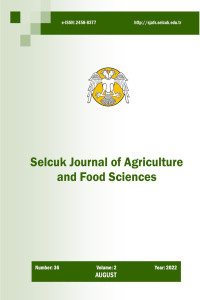Determination of Combining Ability and Heredity Through Diallel Analysis Method in F2 Populations of Cowpea
Abstract
Cowpea is an essential economic crop in underdeveloped and developing countries mainly grown by small farmers. The parents and F2 populations obtained for the F1 generation were planted, in 3 rows of 2 m in length, with row spacing of 45 cm, row spacing of 10 cm and in the ecological conditions of Konya in 2021. The 20 F2 populations and 5 parents were evaluated in the 2021 grown season. General combining ability (GCA) effects for various parents differed significantly. “Sırma” gave significant, positive GCA effects for the number of pod per plant, number of seeds per plant, seed yield per plant and protein yield in plant. Significant, positive specific combining ability (SCA) effects were smaller and less significant than GCA effects. The non-additive dominant gene effect was determined for all the traits. Heterosis of the F2 over the high-parent was observed in five F2 populations. In the terms of combining ability for yield, the best parent was “Sırma”. The heterosis for a yield of F2 hybrids resulted mainly from an increased number of seeds per plant, hundred seed weight. These results suggest that high yielding F2 cowpea populations can be developed that may contain acceptable levels of superior agronomic and techno-logical characteristics.
Keywords
Details
| Primary Language | English |
|---|---|
| Subjects | Agronomy |
| Journal Section | Research Article |
| Authors | |
| Publication Date | December 25, 2022 |
| Submission Date | August 9, 2022 |
| Published in Issue | Year 2022 Volume: 36 Issue: 3 |
Cite
Selcuk Agricultural and Food Sciences is licensed under a Creative Commons Attribution-NonCommercial 4.0 International License (CC BY NC).

